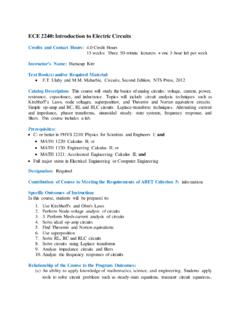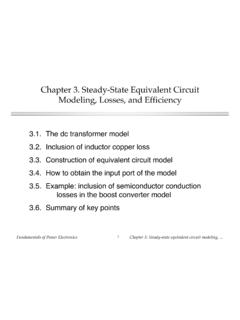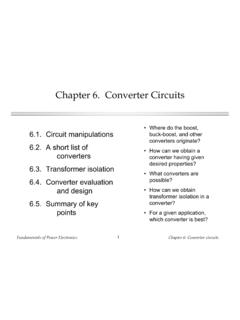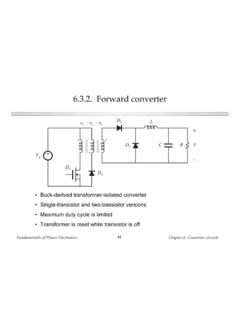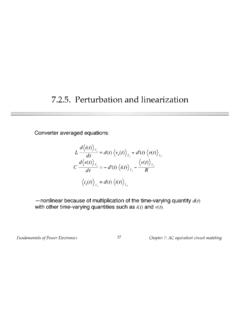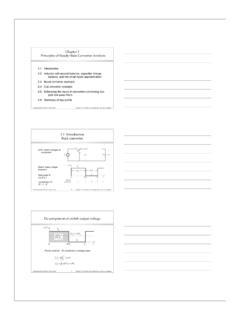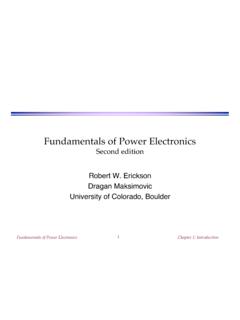Transcription of ECE 5610: Power Electronics Fundamentals
1 ece 5610 : Power Electronics Fundamentals Credits and Contact Hours: Credit Hours 15 weeks: Two 80-minute lectures + one 3-hour lab per week Instructor s Name: John Palmer Text Book(s) and/or Required Material: N. Mohan, Power Electronics : A First Course, John Wiley & Sons, 2012 Catalog Description: This course will introduce the Power Electronics basis and its applications. Students will learn about dc-dc converters dc-ac inverters, solid state Power devices, and applications of Power Electronics in renewable energy area. In present days, Power Electronics is an extremely demanding field especially for the development of plug-in hybrid vehicles and renewable energy harvesting.
2 Therefore, this course should be considered as a gateway to many other courses in Power engineering. Prerequisites: C- or better in: ECE 2280: Fund. of Engineering Electronics ; and ECE 3110: Engineering Electronics II; and Full major status in Computer Engineering Designation: Elective Contribution of Course to Meeting the Requirements of ABET Criterion 5: This course teaches engineering sciences and engineering design. Specific Outcomes of Instruction: This course takes in the study of Power Electronics the means by which electrical energy is controlled directly.
3 Students will be introduced to the broad range of theory and methods related to Power Electronics analysis and design. In the process, they will: 1. Understand the use of Power Electronics as a means of control of energy. 2. Learn and effectively use computational tools for the analysis of Power Electronics . 3. Understand the purpose and application of Power Electronics in a wide range of topologies. 4. Be able to analyze characteristics associated with Power Electronics converters including THD, ripple, efficiency, voltage regulation, etc. Relationship of the Course to the Program Outcomes: (a) An ability to apply knowledge of mathematics, science, and engineering.
4 In this course, students analyze Power Electronics circuits including the application of first order differential equations in the roles of capacitance and inductance in Power Electronics circuits. Principles of energy efficiency and heat transfer are also addressed. (b) An ability to design and conduct experiments, as well as to analyze and interpret data, and to debug and analyze software. The laboratory exercises include the simulation of Power Electronics circuit topologies and the construction of the same circuits for physical measurements in the lab.
5 Evaluation and interpretation of data includes comparison of the simulated performance against the real measurements. (c) An ability to design a system, component, process or software package to meet desired needs. Design principles addressed in the course include a discussion of environmenta l constraints, tradeoffs between energy storage component size and the switching frequency with its associated increase in losses and heat sink size. A significant component of the course is involved in tying the application principles back to the need for sustainability as it relates to energy production and utilization for society.
6 (d) An ability to function on multidisciplinary teams. Thermal constraints, heat transfer principles, and waste energy removal which are traditionally associated with mechanical enginee r ing are included in addition to the electric circuit analysis and design. (e) An ability to identify, formulate, and solve engineering problems. Readings, lectures, and homeworks include information and training on evaluation of applications in which different circuit topologies are appropriate, and evaluating losses and requirements for heat sinks and other mechanisms for extracting waste heat.
7 (g) An ability to communicate effectively. Written reports for laboratory exercises are submitted weekly. (h) The broad education necessary to understand the impact of engineering solutions in a global, economic, environmental, and societal context. A substantial portion of the course addresses means by which to interface with alternative energy sources and improve energy efficiency, both of which are tied into the global, economic, environmental and societal context. (k) An ability to use the techniques, skills, and modern engineering tools necessary for engineering practice.
8 This course includes both discussion of both theoretical analysis and simulation of circuits for design purposes. Topics Covered in the Course: Applications and the Role of Power Electronics for Energy Efficiency and Sustainable Energy Design of Switching Power Poles/Fundamental Switch-mode Building Block DC-DC Converter Analysis and Design Feedback Control of Switch-Mode Power Supplies AC-DC Converter Analysis and Design Power Factor Correction Magnetic Circuit Applications and Design Power Electronics for motor drives Switched mode Power supply design Power Electronics for PV-based Power generation Power Electronics for Hybrid-electric vehicles Utility
9 Applications of Power Electronics



